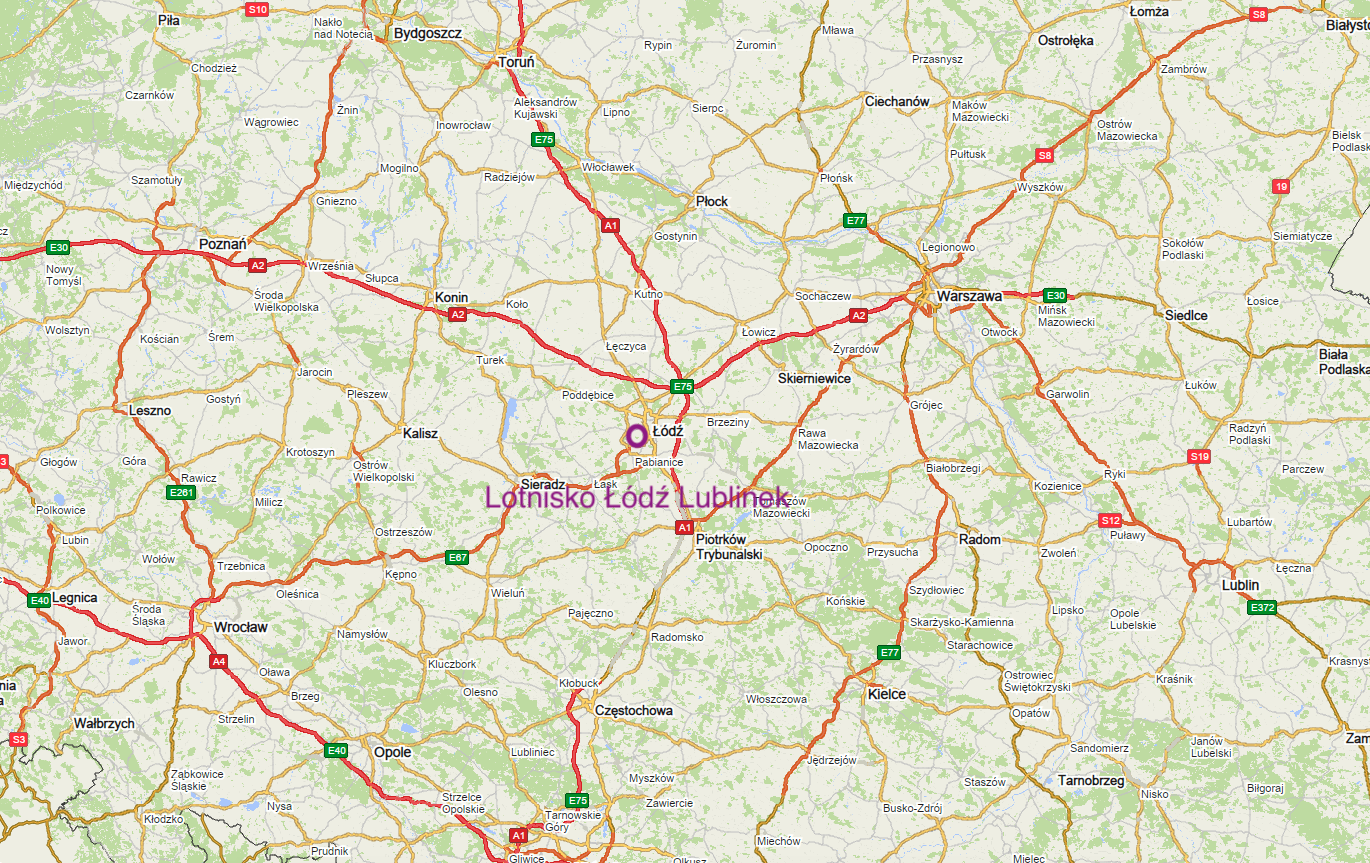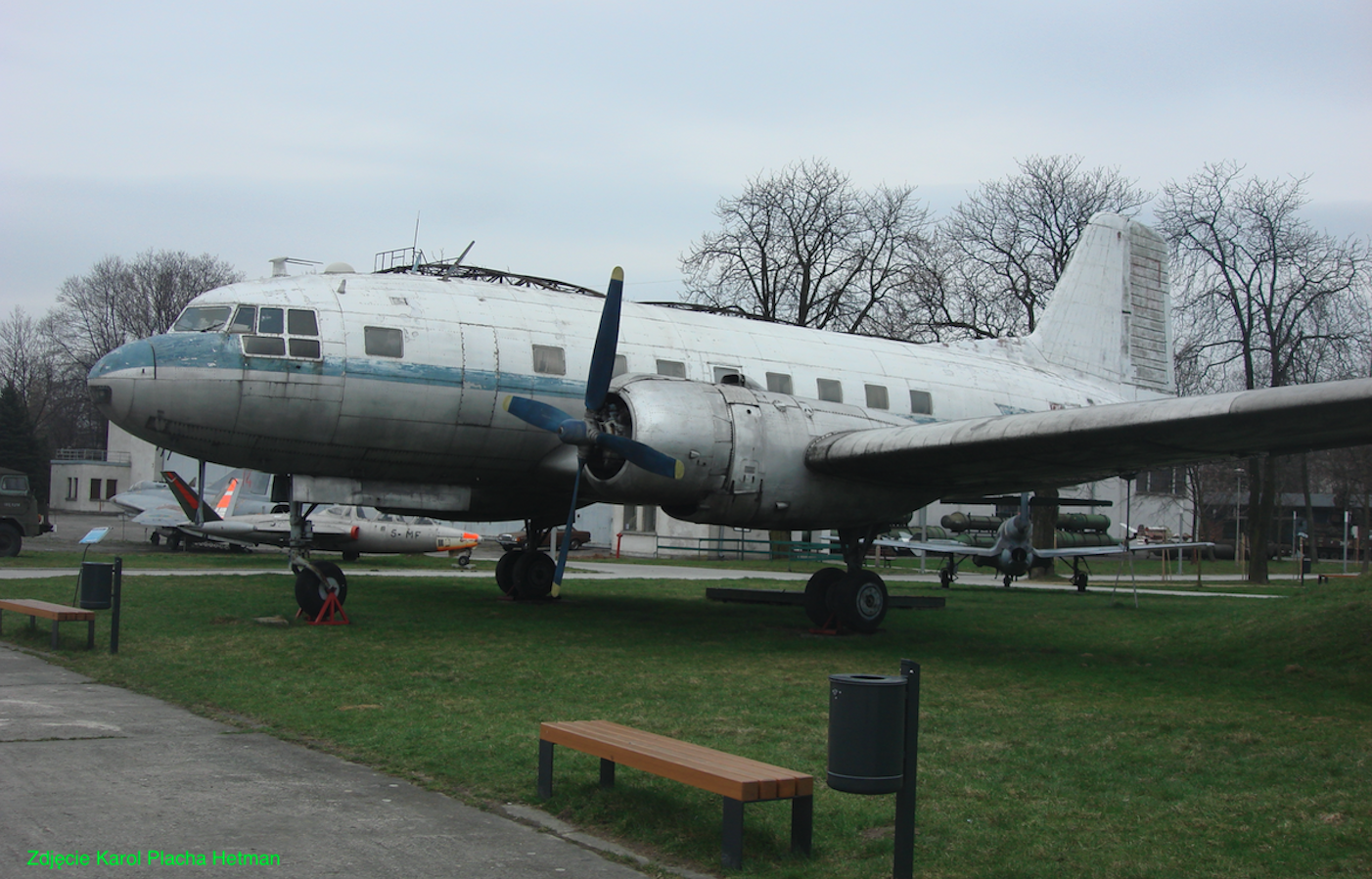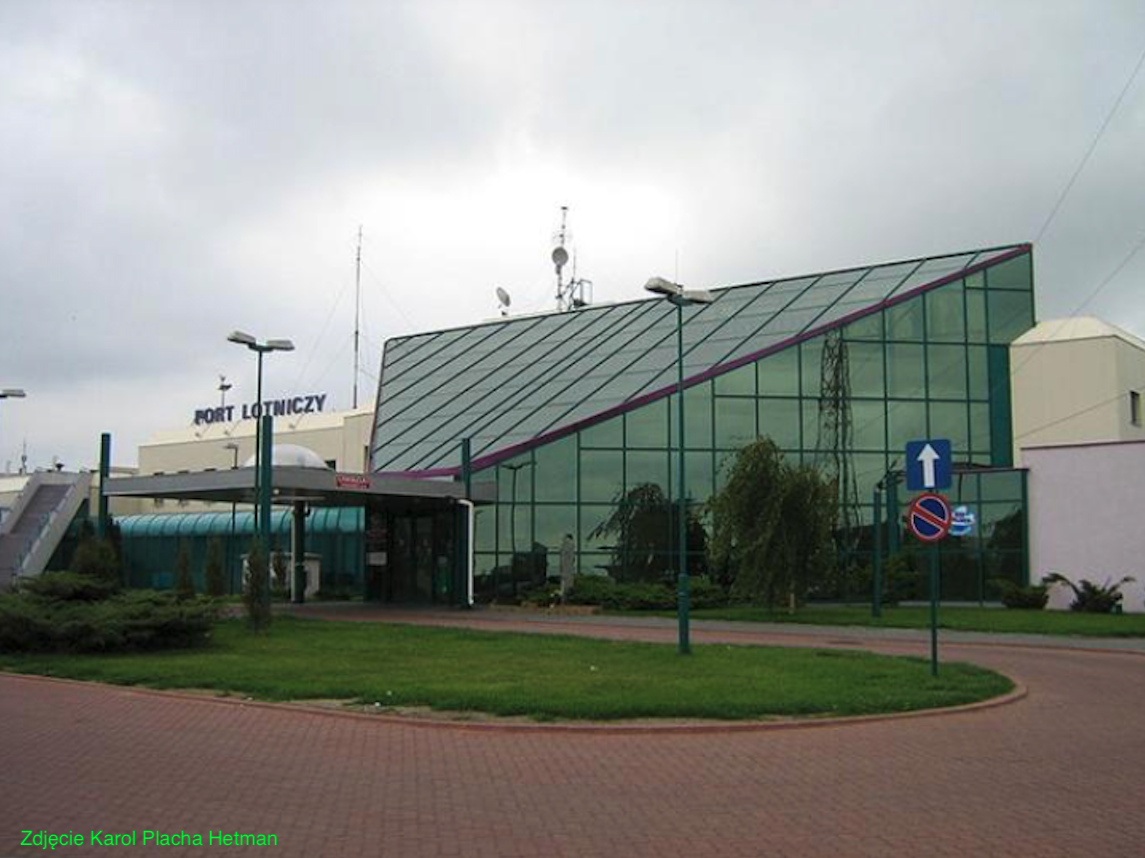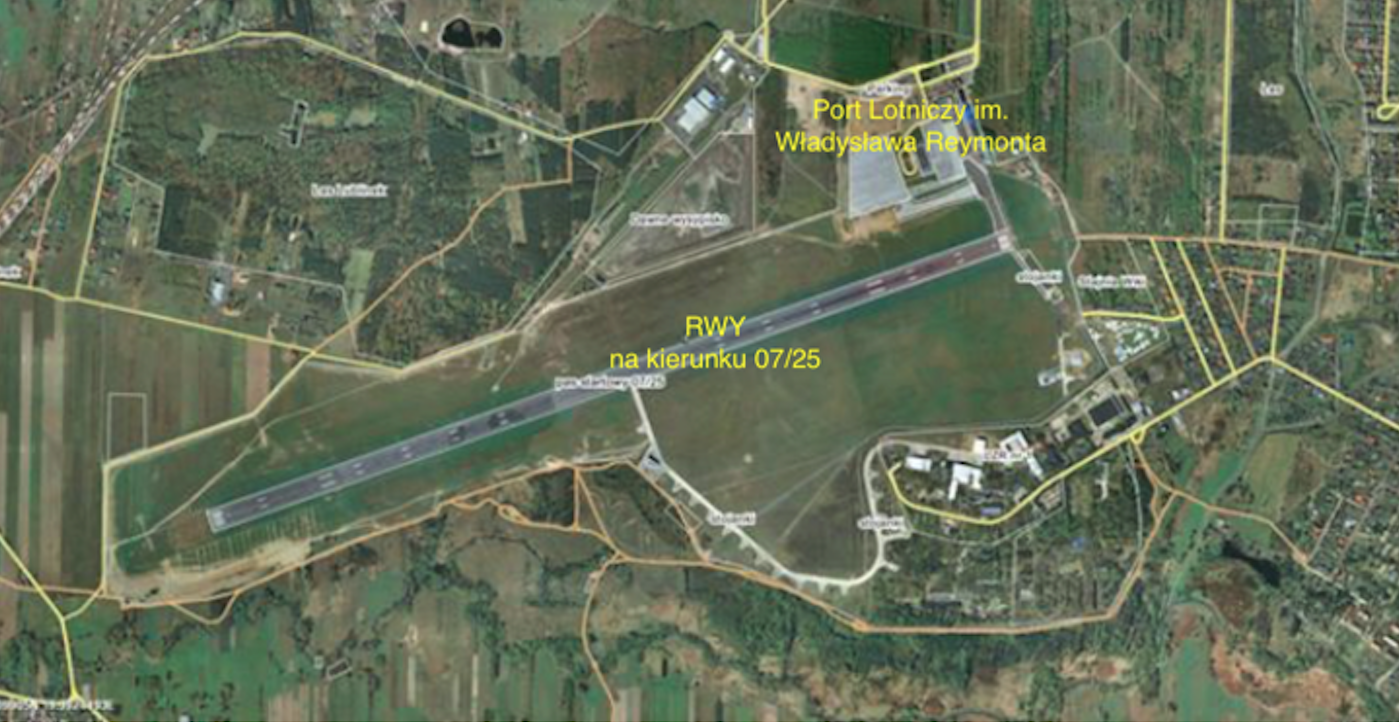Łódź 2013-01-18
Lotnisko Łódź – Lublinek.
Współrzędne geograficzne: 51.719N 19.389E.
Historia Lotniska Lublinek w Łodzi.
Zamysł powstania Lotniska koło przemysłowej Łodzi zrodził się w pierwszych latach po odzyskaniu przez Rzeczpospolitą Polskę niepodległości. Korzystny teren znaleziono na zachód od Miasta na obszarach Miejscowości Lublinek i Nowy Józefów. Grunty te były polami uprawnymi, a także spora ich część była nieużytkami. Do budowy przystąpiono w 1924 roku. Lotnisko zajęło około 100 hektarów. Zbudowano trzy drewniane hangary, warsztaty, stacje paliw i zaplecze socjalne. Obiekty te mieściły się na terenie obecnych Wojskowych Zakładów Lotniczych Nr 1. W zamyśle oprócz funkcji komercyjnych na Lotnisku zamierzano zorganizować szkołę pilotów i mechaników. W dniu 13 września 1925 roku, uroczyście otwarto Lotnisko. Na uroczystości przybył wiceminister Julian Eberhardt (Utalentowany Polski inżynier kolejowy, drogowy i mostowy. W Rządach II Rzeczypospolitej Polskiej pełnił funkcje Wiceministra i kierownika Ministerstwa Komunikacji). Poświecenia lotniska dokonał i mszy świętej przewodniczył Ksiądz Biskup Wincenty Tymieniecki (pierwszy biskup Diecezji Łódzkiej, w okresie 1921 – 1934). Na uroczystości obecne były także; lokalne władze państwowe, samorządowe i wojskowe oraz tysiące mieszkańców Miasta Łódź i okolic. Lotnisko pełniło funkcje wojskowo-cywilne. W kwietniu 1927 roku, uruchomiono regularne połączenia z Łodzido; Warszawy, Poznania, Lwowa i Wilna. W tym czasie Łódź miała największą w Polsce sieć krajowych połączeń. Rozwijał się transport poczty, pieniędzy i towarów. Na lotnisku przybywało samolotów należących do wielkich fabrykantów Łodzi. W 30-latach XX wieku Lotnisko systematycznie rozbudowywano. Zbudowano dwa wielkie nowoczesne murowane hangary, stojące do chwili obecnej (2013 rok). Zbudowano nową stację paliw. Oddano do użytku nowy budynek dworca lotniczego (przy ulicy Stanisława Dubois), wieżę kontroli ruchu i zaplecze administracyjno-socjalne. Zbudowano częściowo utwardzoną drogę startową, wyłożoną kostką bazaltową, o szerokości 15 m i długości 500 m. Opracowano plany utwardzonych dróg startowych i dróg kołowania. Rozbudowywano warsztaty lotnicze. Silny przemysł tekstylny sprzyjał rozwojowi Lotniska.
Dalszy rozwój Lotniska przerwała agresja germańców na Rzeczpospolitą Polskę, w dniu 1 września 1939 roku. Germańcy wykorzystali Lotnisko na potrzeby wojenne. W warsztatach remontowali samoloty bojowe. Znacznie powiększyli terenLotniska z uwagi na dużą ilość ściągniętych tu do remontu wraków. W 1943 roku, rozbudowali RWY do długości 1 200 m, dając jej nawierzchnię betonową.
W nowej rzeczywistości. 1945 rok.
W jesieni 1945 roku, PLL LOT uruchomiło połączenia krajowe, korzystając z Lotniska Lublinek. Lotnisko to weszło w skład I i II linii okrężnej. I linia okrężna to; Warszawa-Lublin-Rzeszów-Kraków-Łódź-Warszawa. II linia okrężna to; Warszawa-Łódź-Katowice-Wrocław-Poznań-Łódź-Warszawa. W ten sposób Lotnisko Lubilnek stało się drugim, co do wielkości ruchu lotniskiem w Polsce po Okęciu. Jednak nie łudźmy się; Tymi samolotami nie latali zwykli obywatele. Na pokładach przebywali głównie wojskowi, milicjanci i działacze partyjni, utrwalający nowy ład społeczny. Od 1949 roku, pojawiły się połączeniawiążące trzy lotniska. Na przykład; Warszawa-Łódź-Wrocław i z powrotem oraz Warszawa-Łódź-Poznań. W 1958 roku, nowa władza państwowa, pod przywództwem Władysława Gomułki, uznała podróże samolotem za zbytek imperialistyczny i drastycznie ograniczyła sieć połączeń PLL LOT. Lotnisko Lublinek odczuło to najbardziej, bo w 1958 roku, zostało zamknięte dla ruchu pasażerskiego. Sam Władysław Gomułka podróżował samolotem Ił-14 (salonka), który można obecnie (2013 rok) oglądać w Muzeum Lotnictwa Polskiego w Czyżynach. Drugi taki samolot stał w Muzeum Lublinek, ale został przeniesiony do muzeum w Dęblinie. Władysław Gomułka oficjalnie mówił, że woli pociągi, choć kiedy tylko miał okazję leciał samolotem (Podobnie jak Premier Rzeczypospolitej Polski – Donald Tusk: miłośnik Tu-154 M i Jak-40, a po zamachu Smoleńskim przesiadł się na samoloty Embraer 175). Od 1958 roku, Lotnisko Lublinek stało się bazą dla Aeroklubu Łódzkiego, Lotniczego Pogotowia Ratunkowego i Lotniczych Zakładów Remontowych. Dla aeroklubu i pogotowia ratunkowe miejsce znaleziono po północno-wschodniej stronie Lotniska, na nieużytkach.
W kolejnych dekadach losy Lotniska Lublinek zmierzały do idei jego całkowitej likwidacji i przeznaczenia terenu pod zabudowę mieszkaniową (4-piętrowe oraz 10-piętrowe bloki mieszkalne). Na przeszkodzie stało jednak wojsko i Wojskowe Zakłady Remontowe, które od początku 60-lat, stały się specjalistą od remontu śmigłowców. Dzięki takiej sytuacji, Lotniskobyło doskonałym miejscem dla rozgrywania niezliczonych zawodów lotniczych; samolotowych, szybowcowych, śmigłowcowych i modelarskich. O zakresie regionalnym, krajowym i międzynarodowym. Bliskość Miasta pozwalała na znalezienie noclegu i to nie koniecznie w hotelu, a na przykład u zawodników mieszkających w Łodzi lub ich znajomych.
W dniu 13 czerwca 1987 roku, na płycie Lotniska Lublinek odbyła się uroczysta msza święta podczas III pielgrzymki Papieża Jana Pawła II do Ojczyzny. Ojciec Święty przybył na Lotnisko śmigłowcem Mi-8.
Razem z przemianami społeczno-gospodarczymi (1989 rok) nastąpił powrót do idei lotniska komunikacyjnego. Z uwagi na niskie nakłady finansowe poprzestano wówczas na idei lotniska regionalnego. Było to związane z pomysłem budowy Centralnego Portu Lotniczego dla Polski. Z regionalnych portów pasażer dolatywałby do Portu Centralnego i stąd leciał na przykład do USA. Taki centralny port miał powstać między Warszawa, a Łodzią. Było kilka lokalizacji. Idei tej nie zrealizował żaden z naszych rządów. Życie pokazało, że pasażerowie nie chcą się przesiadać. Chcą za jednym razem dolecieć do celu lub w jego pobliże.
W pierwszej połowie 90-lat na Lotnisku wykonano szereg modernizacji, aby uzyskać stosowny certyfikat. Decyzją prezydenta Łodzi, Grzegorza Palki utworzono lotnisko dyspozycyjne, obsługujące mały ruch pasażerski (awionetki, taksówki powietrzne). Wybudowano terminal pasażerski przy ul. Generała Stanisława Maczka.
Opis zdjęcia: Terminal pasażerski Lotniska Lublinek, nazywany później Terminalem Nr 1 i Terminalem General Aviation.
W 1996 roku, Lotnisko Lublinek uzyskało status międzynarodowego portu lotniczego. W drugiej połowie 90-lat wykonano na Lotnisku szereg modernizacji. Zmodernizowano RWY wydłużając ją do 1 440 m (było 1 220 m). Przebudowano drogę kołowania. Rozbudowano płytę peronową. Postawiono nowy transformator, aby pokryć zwiększone zapotrzebowanie na energie elektryczną. Zamontowano światła nawigacyjne. Utworzono Lotniskową Straż Pożarną i postawiono budynek dla niej. Oddano do użytku hotel, restaurację i wypożyczalnie samochodów. Lotnisko nie posiadało w tym czasie jeszcze systemu lądowania typu ILS.
W tym momencie Lotnisko było zdolne do przyjmowania samolotów typu ATR 42/72, Jak-40, C-130 Herkules, BAe 146 (cztero silnikowy), Falcon 2000, Bombardier DHC-8.
Pierwszy lot komercyjny na trasie Łódź-Warszawa odbył się w dniu 21.04.1999 roku. Samolot ATR 42. Jednak loty były zakłócane warunkami pogodowymi. Wkrótce loty te zawieszono. PLL LOT tłumaczył zawieszenie lotów niską frekwencją i brakiem systemu ILS. Do tego należy dorzucić zły rozkład lotów i drogie bilety. Szybciej, taniej i wygodniej było pojechać do Warszawy pociągiem.
System ILS uruchomiono w lipcu 2002 roku.
W 2004 roku, Lotnisko Lublinek zostało, jako jedyne w Polsce, wpisane do traktatu akcesyjnego (przystąpienia Polski do Unii Europejskiej), jako lotnisko miejskie, co może w przyszłości skutkować licznymi ograniczeniami nałożonymi przez ULC (Urząd Lotnictwa Cywilnego). Na przykład ograniczeniem ilości startów i lądowań do jednego dziennie, co w praktyce uniemożliwirozwój. Za tą poprawką głosowała większość łódzkich posłów(!).
W 2004 roku, władze Lotniska Lublinek podjęły rozmowy z linią lotniczą European Air Express (EAE). European Air Express były regionalną linią z siedzibą w Mönchengladbach, germańcy. Firma założona była w 1999 roku. Działała na terenie rajchu ikrajów sąsiedzkich. Firma została zlikwidowana w 2007 roku.
Oba podmioty dogadały się i podpisano umowę o współpracy. W dniu 29.03.2004 roku, linia lotnicza European Air Express (EAE) uruchomiła pierwsze międzynarodowe połączenie z Łodzi do Kolonii, samolotami ATR 42. Jednak już po 6 miesiącach loty zostały zawieszone. Powodem były zbyt wysokie ceny biletów, ograniczenia w rezerwacji biletów i brak możliwości zabierania bagażu podręcznego (tylko torebka lub aktówka).
Także w 2004 roku, władze Lotniska Lublinek podpisały umowę z liniami Cimber Air (Bardziej znane, jako Cimber Sterling. Cimber Air to linie duńskie, które zostały zlikwidowane w 2012 roku). Uruchomiono połączenie Łódź-Kopenhaga, które funkcjonowało od kwietnia 2004 roku do marca 2005 roku.
Głównym problemem Lotniska była jednak zbyt krótka droga startowa. Zabezpieczała w zasadzie tylko możliwość lądowania samolotów turbośmigłowych. Większość linii lotniczych w swoim parku posiadała już głównie samoloty Boeing B 737 i Airbus A 320. Te maszyny nie mogły latać do Łodzi. Dlatego w 2004 roku, podjęto decyzje o wydłużeniu RWY z 1 440 m do 2 100m. Prace przeprowadzono w okresie od marca 2005 roku do sierpnia 2005 roku. Jednocześnie po raz kolejny rozbudowano płytę peronową, w taki sposób, że w 2007 roku, miała 8 stanowisk dla samolotów klasy B 737.
Równolegle rozpoczęto rozmowy z firmą Ryanair (największą nisko-kosztową linią w Europie). Jednym z ważnych tematów tych rozmów była infrastruktura Lotniska, która musiała być dostosowana do operowania większych samolotów.
Aby Lotnisko mogło przyjmować samoloty klasy B 737, A 320 konieczne okazało się dokupienie dla Lotniskowej Straży Pożarnej wozu bojowego 4-osiowego o odpowiednim przyspieszeniu. W październiku 2005 roku, Zarząd Województwa sfinansował zakup, wozu w wysokości 1 miliona złotych. Na Lotnisku wóz pojawił się w styczniu 2006 roku. Wóz wykonała Polska firma Moto Truck z Kielc, na podwozu mercedesa. Firma od 1996 roku, specjalizuje się w wozach bojowych dlastraży pożarnej na podwoziach różnych producentów, 2/3/4-osiowych. W dniu 17.11.2011 roku, Lotniskowa Straż Pożarna otrzymała kolejny nowoczesny wóz bojowy Iveco Magirus Super Dragon 2. Wóz ma dwa silniki o łącznej mocy 1 120 KM, zbiornik 17 500 litrów wody, 2 300 litrów środka pianotwórczego oraz 500 kg proszku gaśniczego. Pojazd posiada napęd 8×8, 4-osie, jego długość to 13,1 metra, szerokość 3 m, wysokość 3,6 m. Do prędkości 80 km/h rozpędza się w 21 sekund, ajego maksymalna prędkość to 150 km/h pomimo wagi ponad 50 ton. Producentem wozu jest firma Iveco. Koszt zakupu Super Dragona to 1,16 mln Euro.
Kolejną konieczną zmianą na Lotnisku Lublinek dla przyjmowania samolotów klasy B 737, A 320, było poszerzenie pasa startowego. Nie mylić z droga startową. Uczyniono to w 2005 roku, poprzez przestawienie oświetleniakrawędziowego z krawędzi RWY na trawę, co poszerzyło pas startowy z 30 do 45 m.
W dniu 29.10.2005 roku, uroczyście oddano do użytku Terminal II. Został on wybudowany w rekordowo krótkim czasie 70 dni. Koszt budowy wyniósł 5 917 000 złotych. Obiekt ma modułową konstrukcję, nietrwałe związaną z gruntem. Budynek został zaprojektowany przez Biuro Projektowe Piotra Bilińskiego, a wykonawcą była firma Remo-Bud (ta sama, która przedłużyła drogę startową). Obiekt przeznaczony jest do obsługi pasażerów oraz zawiera pomieszczenia przeznaczone dla służb specjalistycznych, sale odlotów i przylotów, pomieszczenia biurowe, wydzieloną część handlowo usługową. Jest zdolny obsłużyć dziesięciokrotnie większą liczbę pasażerów niż dotychczasowy terminal, czyli 500 tys. osób rocznie. Hala ma niecałe 2 tys. m2 powierzchni, kubaturę 9327,0 m3, a sala odlotów może pomieścić 200 osób (w tym 160 miejsc siedzących).W 2012 roku, obiekt został sprzedany za kwotę 2 000 000 złotych władzom Radomia i ma stanąć na Lotnisku Radom Sadków.
W dniu 30.10.2005 roku, przyleciał pierwszy samolot B 737-800 firmy Ryanair, rejsem FR2468 z Londynu. Lądowanie nastąpiło około godziny 09;20. Samolot przywiózł 175 pasażerów, a ma 189 miejsc pasażerskich. Wykorzystanie miejsc wyniosło 93 %. O godzinie 10;05 ze 177 osobami na pokładzie wystartował w lot z Łodzi do Londynu. Tak zainaugurowano nowe połączenie. Fakt ten oglądało około 3 000 łodzian zebranych obok Lotniska Lublinek.
W grudniu 2005 roku, Polska firma Jet Air uruchomiła połączenie z Warszawą turbośmigłowymi samolotami typu Jetstream J32. Samolot ma 18 miejsc pasażerskich. Firma Jet Air loty wykonywała korzystając z porozumienia zawartego z PLL LOT. Niestety, firma Jet Air weszła w struktury OLT germany i została zlikwidowana w 2012 roku.
W 2006 roku, ogłoszono zmianę nazwy portu na lotnisko imienia Władysława Reymonta. Port lotniczy Łódź im. Władysława Reymonta.
W 2006 roku, firma Ryanair uruchamia kolejne połączenia. Między innymi do East Midlands i Dublina.
W 2006 roku, na rynku próbuje zaistnieć nowa Polska linia Centralwings, która miała silnie powiązana z PLL LOT. W marcu 2006 roku, podjęła loty z Łodzi do Dublina, lecz już w maju 2006 roku, zawiesiła połączenie. W dniu 19.02.2007 roku, uruchomiła połączenia do Rzymu i Paryża. Centralwings zamknęła działalność w 2009 roku.
W 2006 roku, zapadły decyzje o wydłużenie drogi startowej z 2 100 m do 2 500 metrów. Pozwoliło to na przyjmowanie samolotów B 757, B 767, A 330. Rozpoczęto montowanie nowego oświetlenia. Poszerzono drogi kołowania z 12 m do 32 m i powiększono płytę peronową. W styczniu 2007 roku, wydłużona RWY została oddana do eksploatacji. Wydłużenie pasa i instalacja nowego oświetlenia kosztowały 21 mln złotych. W 2007 roku, z budżetu państwowego przyznano 37 milionów złotych na budowę Nowego Terminala Pasażerskiego.
W dniu 7.02.2007 roku, oddano do użytku nową remizę lotniskowej straży pożarnej. Było to podyktowane nowymi przepisami nakazującymi umiejscowienie remizy w pobliżu RWY. W ten sposób uległa skróceniu droga i czas do ewentualnego wypadku samolotu. Oprócz tego remizy wyposażono w stanowisko obserwacyjne z monitoringiem lądujących i startujących samolotów.Nie niżej niż 10 m nad płaszczyzną lotniska, z widocznością całego pola wzlotów. W ten sposób postawiono już remizy na lotniskach; Balice, Ławica, inne. W Lublinku remiza ma własne źródło energii elektrycznej i zbiorniki na wodę i środek pianotwórczy 4 x 54 m3. Remiza kosztowała 7 milionów złotych. Zapewnia wysokie bezpieczeństwo, do kategorii VII.
W dniu 29.03.2008 roku, na Lotnisku Lublinek wylądował pierwszy raz Boeing 757-200 izraelskich linii lotniczych El Al inaugurując tym samym połączenia z Łodzi do Tel Awiwu.
W kwietniu 2008 roku, na Lotnisku Lublinek doszło do zdarzenia prawie wypadkowego. Boeing B 737 ze 168 osobami na pokładzie miał wystartować do East Midlands o godz. 10;30. Kołując po pasie startowym, maszyna zboczyła z trasy iwpadła przednim kołem w piach. (kołowanie po RWY w Lublinku jest standardem, bo nie ma jeszcze bocznej drogi kołowania. Podobnie jest w Jasionce, Modlinie, Świdnik-Lublin i setkach innych portów na świecie). Gdy tylko samolot zjechał zpasa, dyżurny portu ogłosił alarm. Nie minęło 180 sekund, jak przy samolocie była lotniskowa straż pożarna, by upewnić się, że nie ma wycieku paliwa i czy nie ma rannych. Pasażerów ewakuowano. Autobusy były w kwadrans i zabrały pasażerów do terminalu. Nikt nie ucierpiał. Kraniec RWY wyznaczają długie na 5 m i szerokie na metr białe pasy oraz światła ostrzegawcze. Strefa awaryjnego hamowania ma 90 m długości i 60 m szerokości. Ona właśnie jest wypełniona piachem, by samolot miękko w nim osiadł w takich sytuacjach. Samolotu natychmiast nie można było zabrać z miejsca zdarzenia, bo o jego losie decyduje użytkownik, czyli Ryanair. To jej specjaliści decydowali jak należy wyciągnąć samolot. Gdzie podpiąć liny holujące. Samolot odholowano po 12 godzinach. Służby Lotniska spisały się wzorowo. Winny był pilot – orzekła Państwowa Komisja Badania Wypadków Lotniczych.
Najnowsza płyta peronowa została umieszczona po zachodniej stronie Terminalu II, a od południa dla Terminalu III, który był wówczas w planach. Ma kształt trapezu i powierzchnię 31 000 m2. Jej budowa trwała 7 miesięcy i kosztowała 31 milionów złotych. Przekazano ja do użytku w dniu 12.06.2008 roku. W uroczystości otwarcia wziął udział Prezydent RzeczypospolitejPolski profesor Lech Kaczyński.
W 2008 roku, firma Ryanair uruchomiła kolejne połączenie do Sztokholmu, a w 2010 roku, do Mediolanu-Bergamo.
Od 2009 roku, Lotnisko Lublinek obsługuje loty typu cargo, korzystając z jednego z hangarów należących poprzednio do Aeroklubu Łódzkiego.
W grudniu 2009 roku, rozpoczęto budowę nowego Terminalu III. W dniu 8.01.2010 roku, wmurowano akt erekcyjny. Prace budowlane trwały 18 miesięcy. Budynek ma długość 137 m, szerokość 80 m, wysokość 15 m. Ma cztery kondygnacje,25 600 m2, 15 stanowisk check-in. Obsługuje 2 miliony pasażerów rocznie, a 1 300 osób w ciągu godziny. Koszt budowy to 200 milionów złotych. Oddany był do eksploatacji w dniu 1.06.2012 roku.
W marcu 2010 roku, loty z Łodzi rozpoczęła druga duża linia nisko-kosztowa Wizz Air. Pierwsza trasa została uruchomiona w dniu 30.03.2010 roku, samolotem A 320 do Dortmundu, a potem do Sztokholmu. Kolejna trasa Łódź-Londyn Luton uruchomiona została 2011 roku. W dniu 12.04.2010 roku, z Mediolanu po włoskich kibiców siatkarskich (Final Four) przyleciał Boeing 767 200ER. Największy w dotychczasowej historii lotniska samolot.
W 2010 roku, oddano do eksploatacji nową stacje paliw. W 2010 roku, były plany budowy wolnostojącej wieży kontroli lotów. Wieża miała mieć wysokość 40 m i powierzchnię użytkową 1 442 m2. Budynek miał mieć 2-kondygnacje części administracyjno-technicznej oraz 5-kondygnacji operacyjnych. Koszt 11 mln złotych. Ostatecznie wieża kontroli lotów stała się częścią terminalu. W dniu 15.11.2012 roku, oficjalnie przekazano wieżę do użytku.
W dniach 3-6, 10-13 i 17-20 wrzesień 2010 roku, w związku z remontem drogi startowej na Okęciu Lotnisko Lublinek przejęło sporą część ruchu pasażerskiego. Lotnisko zdało egzamin wzorowo. Za sprawnie przejęcie ruchu Port Lotniczy otrzymał nagrodę Awionetka 2010 i tytuł Najlepszego Portu Lotniczego Roku 2010 oraz zwyciężył w plebiscycie – Łódź sukcesu, w kategorii wydarzenie miesiąca. Ta sytuacja była sporą gratką dla łódzkich spoterów. Lądowały tu samoloty linii lotnicze WizzAir, Norwegia Air Shuttle, LOT Charters, Air Italy Polska, Travel Service Airlines, Eurocypria Airlines, Israir.
W dniu 30.10.2010 roku, minęło 5 lat od inauguracji połączeń linii Ryanair pomiędzy Londynem i Łodzią. Przez ten czaslinie te przewiozły z i na Lublinek 1 230 689 pasażerów.
W październiku 2010 roku, rozpoczęto budowę brakującego odcinka drogi patrolowo–pożarowej w około Lotniska, o długości 1 920 m, szerokości 6 m.
W 2012 roku, Ryanair uruchomił połączenie z Łodzi do Bristolu.
W kwietniu 2012 roku, wystartowała linia OLT Express połączeniami do Wrocławia i Gdańska. Jednak już 31.07.2012 roku, firma zbankrutowała, pozostawiając tysiące pasażerów z niezrealizowanymi biletami. Przy czym OLT germany nadaldobrze funkcjonowała. Skandal – przekręt chłopców z Gdańska i niemiec.
W dniu 1.06.2012 roku, odbyło się uroczyste otwarcie Terminalu III, który w zasadzie stał się Terminalem I. W dniu 2.06.2012 roku, w Terminalu zorganizowano Dzień Otwarty.
W dniu 15.12.2012 roku, na terenie portu lotniczego odsłonięto tablicę upamiętniającą Generała Andrzeja Błasika (1962r.-2010r.), który zginął w zamachu Smoleńskim 10.04.2010 roku. Generał Andrzej Błasik na lotnisku Lublinek zdobył pierwsze uprawnienia pilotażowe.
W dniu 17.01.2013 roku, na Lotnisku Lublinek otwarto nową bazę Lotniczego Pogotowia Ratunkowego.
Dane lotniska Lublinek.
Port Lotniczy Łódź imieniem Władysława Reymonta znajduje się w samym centrum Rzeczypospolitej Polskiej i w centrum Europy. Port zlokalizowany jest około 6 km od centrum Łodzi. W promieniu 50 km od lotniska, w miastach powyżej 10 000 mieszkańców mieszka około 1,4 miliona ludzi. Aktualnie (2013 roku) port lotniczy jest wciąż rozbudowywany. Lotnisko zajmuje 8 miejsce w Polsce pod względem liczby obsłużonych pasażerów.
Kod IATA: LCJ. Współrzędne 51°43’19" N 19°23’53" E. Adres ul. Generała Stanisława Maczka 35. 94-328 Łódź. Sekretariat: +48 42 688 84 14. Centrala: +48 42 683 52 00.
Lotnisko posiada drogę startową o wymiarach 2 500 m x 45 m, na kierunku 07/25, wielokrotnie wydłużaną i poszerzaną. Lotnisko nie posiada równoległej drogi kołowania, dlatego samoloty kołują po RWY. Południowa droga kołowania (wzdłuż stojanek) nie jest wykorzystywana przez pasażerskie samoloty komercyjne. Do płyty peronowej prowadzi tylko jedna droga kołowania Alfa. Aktualnie Lotnisko posiada dwie płyty peronowe; wschodnia i zachodnia. Rozdziela je budynek tymczasowego terminalu, który jest w trakcie rozbiórki i transportu do Radomia. W przyszłości obie płyty peronowe zostaną połączone w jedną. Wówczas powierzchnia wyniesie około 60 000 m2.
Lotnisko może obsłużyć do 2 milionów pasażerów rocznie. Komunikację do lotniska zapewnia miejskie przedsiębiorstwo komunikacyjne autobusami. Na lotnisku dostępne są paliwa lotnicze JET-A1 oraz AVGAS 110L.
Opracował Karol Placha Hetman




